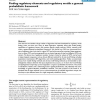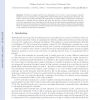371 search results - page 4 / 75 » Algorithms for phylogenetic footprinting |
BMCBI
2007
13 years 7 months ago
2007
Over the last two decades a large number of algorithms has been developed for regulatory motif finding. Here we show how many of these algorithms, especially those that model bind...
BIOINFORMATICS
2010
13 years 7 months ago
2010
Phylogenetic trees are widely used to display estimates of how groups of species evolved. Each phylogenetic tree can be seen as a collection of clusters, subgroups of the species ...
CGF
1999
13 years 7 months ago
1999
Computer animations often lack the subtle environmental changes that should occur due to the actions of the characters. Squealing car tires usually leave no skid marks, airplanes ...
BIBE
2010
IEEE
13 years 8 months ago
2010
IEEE
The prediction of gene function from genome sequences is one of the main issues in Bioinformatics. Most computational approaches are based on the similarity between sequences to in...
CPM
2009
Springer
14 years 1 months ago
2009
Springer
Evolution is usually described as a phylogenetic tree, but due to some exchange of genetic material, it can be represented as a phylogenetic network which has an underlying tree st...



